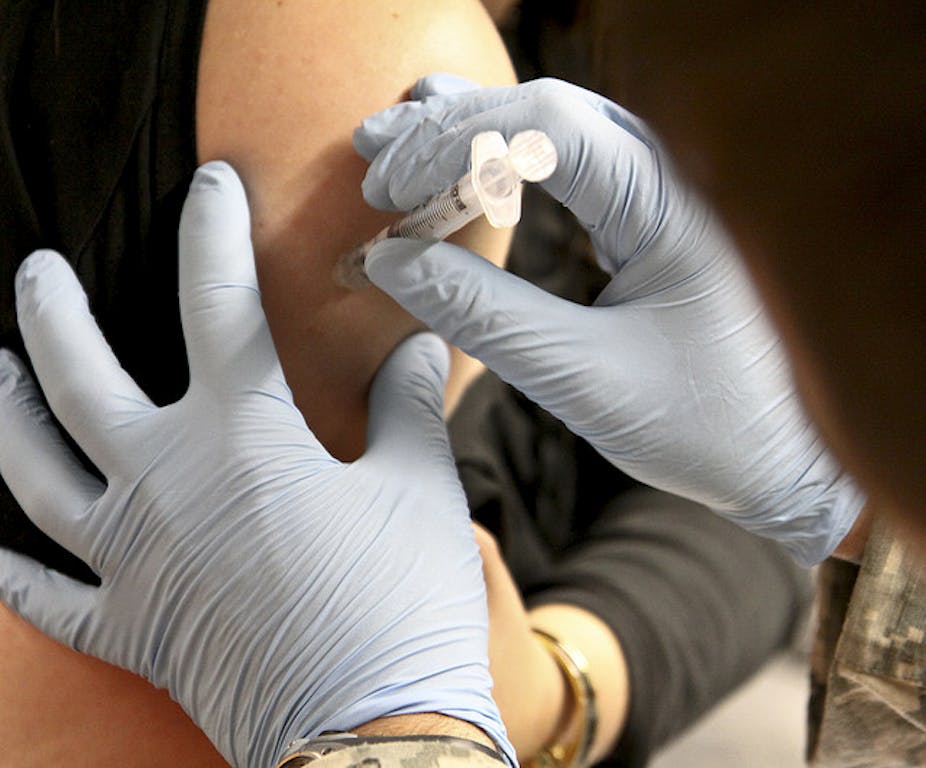Despite high vaccination rates, Australia and other developed countries periodically have small outbreaks of measles, as seen in the recent scares in Victoria and New South Wales.
Until about 40 years ago, serious measles epidemics occurred every two or three years.
Virtually every child was infected within the first few years of life and one or two in every thousand died from complications.
Many were admitted to hospital and some suffered permanent brain damage from encephalitis.
When the measles vaccine was introduced in 1968, the incidence of the disease fell rapidly, but small outbreaks continued.
A national survey in 1989 showed that 85% of Australian children were immunised. But then a large and prolonged measles outbreak in 1993-4 prompted an Australian Measles Control Campaign (MCC) in 1997.
More than 1.33 million children aged between five and 12 were immunised with the measles, mumps, rubella (MMR) vaccine in a school-based programme.
National surveys showed the proportion of primary school-aged children who were immune to measles rose from 84% before to 94% after the MCC. As a result, the number of measles cases fell significantly.
However, the levels of immunity varied in different age-groups. A proportion of young adults, especially males aged between 18 and 22 years were still at risk.
This group was born soon after the measles vaccine became available, when for some years, the level of its uptake was relatively low.
Because it was still high enough to reduce the number of cases, many children reached adulthood without exposure to infection.
In addition, boys born between 1974 and 1980 were not eligible for a second dose of MMR vaccine at secondary school, which, for several years, was given to girls to protect them from rubella during their child-bearing years.
The timing of the second dose was changed to the time of school entry, as part of the MCC, in 1998.
Outbreaks usually start – often among young, predominantly male, adults - with someone who has recently come from a country where measles is still relatively common.
Rapid contact tracing and immunisation usually controls these outbreaks before they spread beyond the immediate contacts of the initial or index case.
There was widespread – some would say hysterical – media coverage of this in the United Kingdom, where the MMR vaccination rate fell from 91% in 1997-8 to 80% in 2003. Naturally, this resulted in a marked increase in the number of measles cases in 2002.
There were similar, but less extreme, reactions in some other countries, but fortunately not in Australia, where the media coverage was limited and generally balanced.
Numerous subsequent articles questioned the methodology and conclusion of the original report and confirmed that the MMR vaccine is safe. In 2010, The Lancet formally retracted the report.
Recently, researchers have presented evidence that measles has been effectively eliminated from Australia as well as from Finland, the United States, South Korea, Mexico, Brazil, Canada and Cuba.
In fact, measles is actually one of the few infectious diseases for which elimination is theoretically possible. Humans are the only reservoir for the virus; there is an effective vaccine; immunity usually lasts for life and infection causes an easily recognised illness that can be confirmed by a simple laboratory test.
Elimination doesn’t mean no more cases but that sustained transmission from imported cases won’t occur. We’ve reached this point in Australia through continued high immunisation rates (with two doses) and an effective surveillance system resulting in rapid control of outbreaks.
Nevertheless, recent outbreaks in New South Wales and Victoria show that this status is difficult to maintain.
When four passengers, who had recently arrived from Malaysia on the same flight, were diagnosed with measles, an alert was issued by the Victorian Department of Health.
The Chief Health Officer requested that patients who had attended the Emergency Department at the same time as the passengers, and other passengers on the flight, contact authorities so they could, if necessary, be immunised.
There was also an increase in notified cases early this year in Western Sydney, which centred around schools, where many pupils were not immunised. Prompt action by the local public health unit to vaccinate local school children stopped the outbreak.
Outbreaks like these can only be prevented by: maintaining high rates of childhood immunisation; targeting groups that miss out for various reasons, including the children of migrants from countries with low vaccine uptake; active surveillance to identify and isolate cases when they occur and; immunisation of contacts, if necessary, to interrupt transmission.
The World Health Organisation (WHO) has been campaigning to improve measles immunisation rates, to support its Millennium Development Goals.
Yet, despite major improvements, many countries remain behind target and measles remains a significant contributor to childhood mortality worldwide.
So, while we live in a global world made smaller with widespread air travel, we remain theoretically measles free while at the same time facing the prospect of periodic measles outbreaks.

